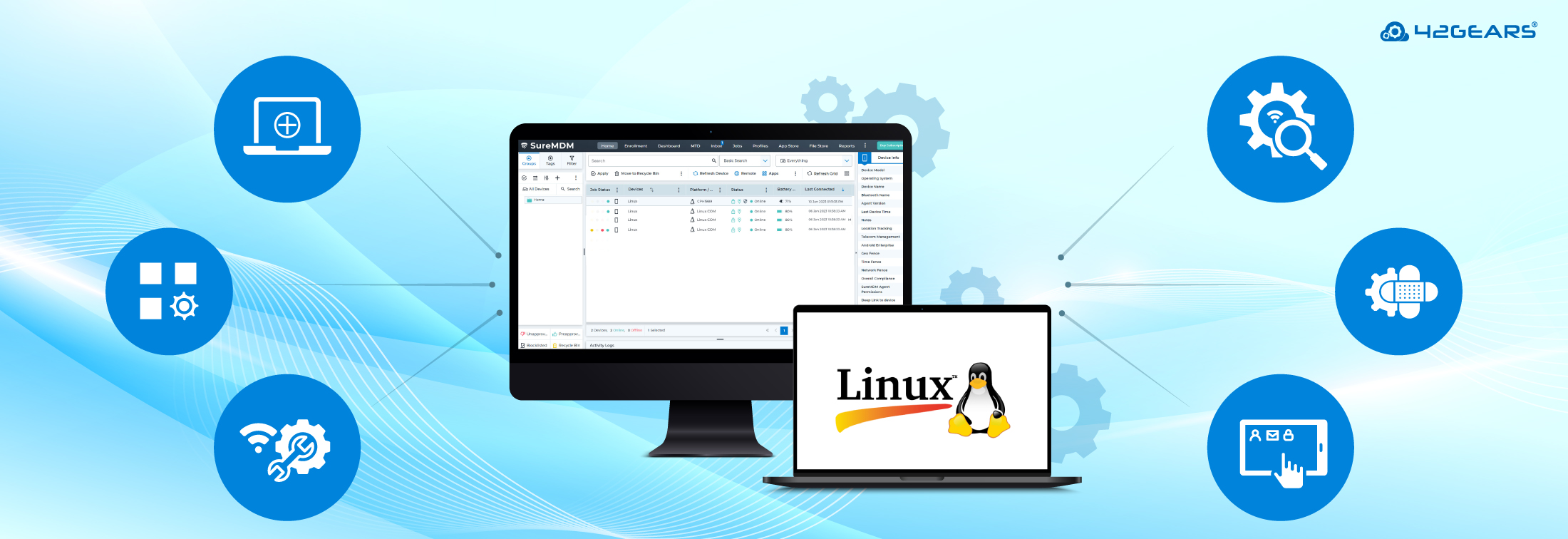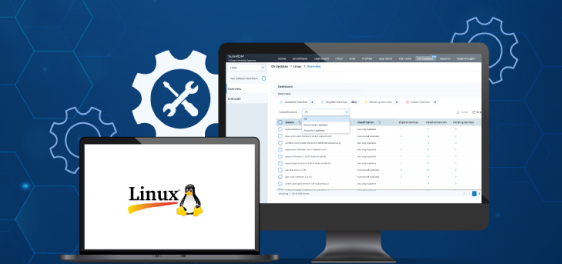Linux Device Management: What It Is and How It Works
jun 20, 2025 | Nareddy Saivikas Reddy
Last Updated: aug 29, 2025
What is a Linux Device?
A Linux device is any laptop, desktop computer, IoT device, or any other appliance that runs on the Linux Operating System or Linux OS. There are many distributions of the Linux OS that are widely used by enterprises, such as Ubuntu, Linux Mint, Red Hat, Fedora, CentOS, etc. They support a variety of use cases, from personal computing to enterprise infrastructure and IoT deployments.
Linux is an open-source operating system known for its stability. It is steadily gaining popularity as an alternative operating system among developers and other users. According to Fortune Business Insights, the global Linux operating system market size is projected to grow from USD 26.41 billion in 2025 to USD 99.69 billion by 2032, exhibiting a CAGR of 20.9%
What is Linux Device Management?
Linux device management refers to the solution used by IT teams to secure, monitor, and manage Linux-based devices across an organization. It includes tasks like patch management, software deployment, access control, and compliance enforcement—often through a centralized platform. This is also called Linux MDM or or Linux management or device management in Linux.
Common Challenges in Linux Device Management
While Linux devices offer flexibility and power, managing Linux devices at scale comes with a unique set of challenges that organizations must overcome to ensure efficiency and security.
- Fragmented Ecosystem
The Linux landscape is highly fragmented, with numerous distributions (and sub-distributions) requiring different management approaches. This lack of standardization creates a heavy IT burden, forcing teams to juggle manual processes and custom scripts for each environment. - Limited Support for Advanced Configurations
Many traditional device management tools don’t offer the depth or flexibility needed for complex Linux setups. This makes it difficult for organizations to implement advanced configurations or enforce specific policies that align with their internal requirements. - Troubleshooting Challenges
Troubleshooting Linux devices remotely can be cumbersome, especially without built-in remote support tools. This often leads to increased device downtime and frustrated end users, ultimately affecting productivity. - Difficulty Managing Lost or Stolen Devices
Without robust device tracking and remote lock/wipe capabilities, lost or stolen Linux devices pose a serious security risk. Sensitive data can be exposed, and lack of centralized control makes it difficult to respond quickly to potential breaches. - Inconsistent Software Updates
Different Linux distributions use various package managers and update systems (e.g., APT, YUM, Zypper), making it hard to apply consistent patching and updates across the entire device fleet. This inconsistency increases the risk of security vulnerabilities due to delayed or missed patches.
To overcome these challenges, organizations need to deploy a Linux MDM solution.
42Gears’ SureMDM for Linux OS is one such tool that allows IT teams to manage, secure, and monitor Linux devices effortlessly from a central web console. The solution allows you to take Linux device management to a whole new level, with granular control and multiple management modes.
In this blog, you will learn more about SureMDM’s features and how they make Linux device management easy.
Key Features of 42Gears' Linux Device Management Solution
- Enrollment: Admins can start managing Linux devices by enrolling them into SureMDM using CLI (Command Line Interface) based Enrollment.
- Remote Configuration: Once enrolled, admins set up devices by configuring security policies, hardware settings, and network settings.
- App Management: Admins can easily manage, monitor, and control applications across all endpoints from a centralized console. With support for in-house apps and access to the SureMDM App Store, IT teams can streamline app deployment, enforce policies, and ensure every device stays secure and business-ready.
- Remote Control: Admins can diagnose and troubleshoot Linux devices remotely to reduce downtime and avoid costly physical handling or shipping. IT teams can view and control device screens without much end-user interaction, capture screenshots, transfer files, and monitor key health metrics like CPU, RAM, and running apps—all from a single console.
- Patch Management: Admins can automate Linux patching to keep enterprise devices secure and compliant. IT teams can configure reboots, schedule or auto-install updates, track status via detailed dashboards, and roll back unstable patches when needed—all from a centralized console.
- Identity and Access Management: Admins can leverage SureIdP, an in-house Identity and Access Management (IAM) solution that offers secure, seamless authentication and centralized access control. Built on zero trust principles, it continuously verifies users and devices, providing granular access controls and cross-platform support.
- Application Kiosk Management: Admins can ensure that Linux devices are used only for authorized purposes by locking them into Linux kiosk mode. IT teams can track app usage, restrict access to settings, and hardware keys to boost productivity and prevent misuse.
- URL Filtering: Admins can enforce URL filtering policies on Linux devices using allowlists, blocklists, or domain-level filtering. Easily upload URLs in bulk via CSV files.
- Sudo Access: Admins can temporarily grant Sudo access to Standard user accounts for performing administrative tasks such as installing applications, modifying system files, and managing device configurations—ensuring control without compromising security.
Why Choose SureMDM for Linux Device Management
SureMDM by 42Gears offers a centralized and unified Linux MDM platform for managing Linux devices in enterprise environments. Here are the key advantages that make it stand out:
- Centralized Management: Easily monitor, manage, and secure all Linux devices from a single, web-based console—streamlining IT operations and reducing manual overhead.
- Scalable: Whether you're managing a few devices or thousands, SureMDM scales effortlessly to support growing business needs.
- Improved IT Efficiency: Automate routine Linux device management tasks like patching, configuration, and software deployment to significantly reduce manual effort. This frees up IT teams to focus on more strategic initiatives.
- Cost Savings: Reduces operational costs by eliminating the need for on-site troubleshooting. With robust remote management capabilities, IT teams can support devices anywhere—minimizing downtime and cutting overhead.
FAQs
Is Linux device management secure for enterprise use?
Can I manage multiple Linux devices remotely?
Is there an MDM (Mobile Device Management) solution for different Linux distributions?
How do I manage Linux desktops in an enterprise environment?
Can Linux tablets be centrally managed using MDM?
What are the common use cases of Linux Device Management?
What is device management in Linux?
What challenges does Linux management help overcome?
What are the key features to look for in an MDM solution for Linux?
How does Linux desktop management improve IT efficiency and reduce costs?
Can Linux desktop management troubleshoot devices remotely?
Take Control of Your Linux Devices Today!
Subscribe for our free newsletter


